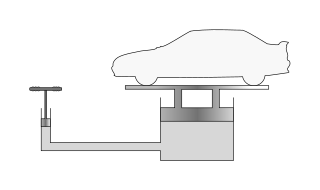Loading AI tools
Principle in fluid mechanics From Wikipedia, the free encyclopedia
Pascal's law (also Pascal's principle[1][2][3] or the principle of transmission of fluid-pressure) is a principle in fluid mechanics given by Blaise Pascal that states that a pressure change at any point in a confined incompressible fluid is transmitted throughout the fluid such that the same change occurs everywhere.[4] The law was established by French mathematician Blaise Pascal in 1653 and published in 1663.[5][6]


Pascal's principle is defined as:
A change in pressure at any point in an enclosed incompressible fluid at rest is transmitted equally and undiminished to all points in all directions throughout the fluid, and the force due to the pressure acts at right angles to the enclosing walls.
For a fluid column in a uniform gravity (e.g. in a hydraulic press), this principle can be stated mathematically as:
where
The intuitive explanation of this formula is that the change in pressure between two elevations is due to the weight of the fluid between the elevations. Alternatively, the result can be interpreted as a pressure change caused by the change of potential energy per unit volume of the liquid due to the existence of the gravitational field.[further explanation needed] Note that the variation with height does not depend on any additional pressures. Therefore, Pascal's law can be interpreted as saying that any change in pressure applied at any given point of the fluid is transmitted undiminished throughout the fluid.
The formula is a specific case of Navier–Stokes equations without inertia and viscosity terms.[7]
If a U-tube is filled with water and pistons are placed at each end, pressure exerted by the left piston will be transmitted throughout the liquid and against the bottom of the right piston (The pistons are simply "plugs" that can slide freely but snugly inside the tube.). The pressure that the left piston exerts against the water will be exactly equal to the pressure the water exerts against the right piston . By using we get . Suppose the tube on the right side is made 50 times wider . If a 1 N load is placed on the left piston (), an additional pressure due to the weight of the load is transmitted throughout the liquid and up against the right piston. This additional pressure on the right piston will cause an upward force which is 50 times bigger than the force on the left piston. The difference between force and pressure is important: the additional pressure is exerted against the entire area of the larger piston. Since there is 50 times the area, 50 times as much force is exerted on the larger piston. Thus, the larger piston will support a 50 N load - fifty times the load on the smaller piston.
Forces can be multiplied using such a device. One newton input produces 50 newtons output. By further increasing the area of the larger piston (or reducing the area of the smaller piston), forces can be multiplied, in principle, by any amount. Pascal's principle underlies the operation of the hydraulic press. The hydraulic press does not violate energy conservation, because a decrease in distance moved compensates for the increase in force. When the small piston is moved downward 100 centimeters, the large piston will be raised only one-fiftieth of this, or 2 centimeters. The input force multiplied by the distance moved by the smaller piston is equal to the output force multiplied by the distance moved by the larger piston; this is one more example of a simple machine operating on the same principle as a mechanical lever.
A typical application of Pascal's principle for gases and liquids is the automobile lift seen in many service stations (the hydraulic jack). Increased air pressure produced by an air compressor is transmitted through the air to the surface of oil in an underground reservoir. The oil, in turn, transmits the pressure to a piston, which lifts the automobile. The relatively low pressure that exerts the lifting force against the piston is about the same as the air pressure in automobile tires. Hydraulics is employed by modern devices ranging from very small to enormous. For example, there are hydraulic pistons in almost all construction machines where heavy loads are involved.
Other applications:

Pascal's barrel is the name of a hydrostatics experiment allegedly performed by Blaise Pascal in 1646.[9] In the experiment, Pascal supposedly inserted a long vertical tube into an (otherwise sealed) barrel filled with water. When water was poured into the vertical tube, the increase in hydrostatic pressure caused the barrel to burst.[9]
The experiment is mentioned nowhere in Pascal's preserved works and it may be apocryphal, attributed to him by 19th-century French authors, among whom the experiment is known as crève-tonneau (approx.: "barrel-buster");[10] nevertheless the experiment remains associated with Pascal in many elementary physics textbooks.[11]
Seamless Wikipedia browsing. On steroids.
Every time you click a link to Wikipedia, Wiktionary or Wikiquote in your browser's search results, it will show the modern Wikiwand interface.
Wikiwand extension is a five stars, simple, with minimum permission required to keep your browsing private, safe and transparent.